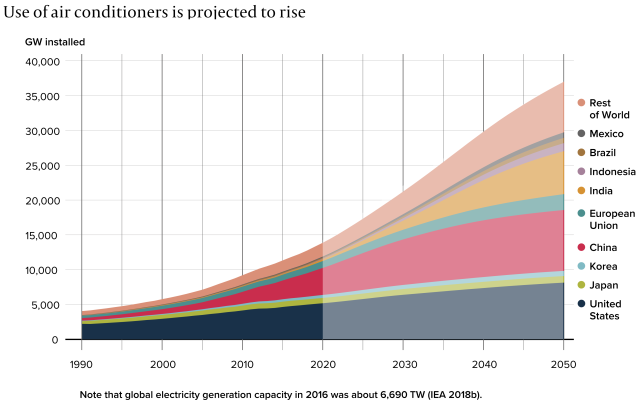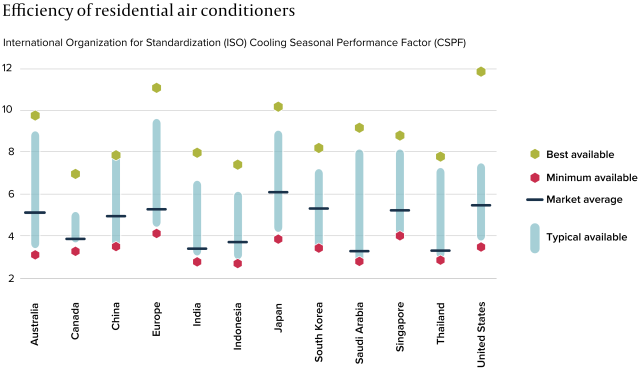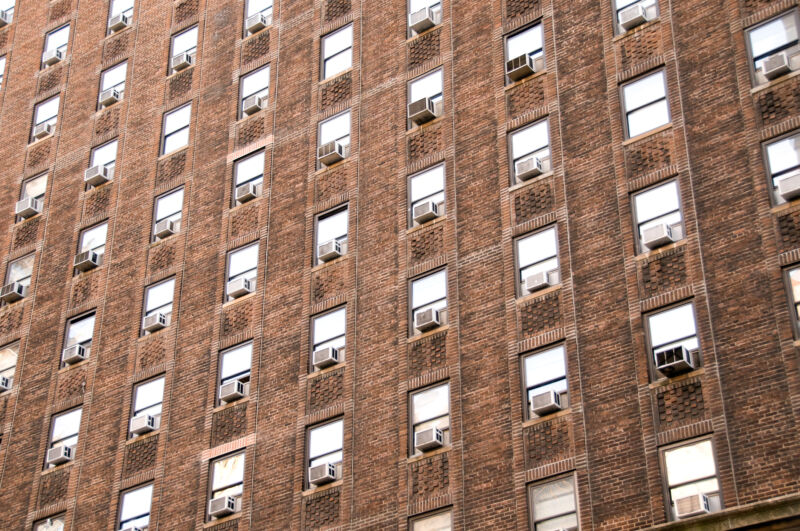It was a monumental day for the environmental movement more than 30 years ago when all 198 countries in the world agreed on something for the first and only time ever. They signed on to the Montreal Protocol, making a pact to phase out a roster of chemicals that damage the Earth’s ozone layer. Chief among these were the chlorofluorocarbons (CFCs) and hydrochlorofluorocarbons used by the cooling and refrigeration industry. Alternatives, such as hydrofluorocarbons (HFCs), were quickly found.
But in recent years, scientists have come to realize that the Montreal Protocol of 1987 might have traded an immediate problem for a long-term one. Though HFCs don’t cause the same damage to the ozone layer as CFCs do, the chemicals have warming potentials hundreds to thousands of times higher than that of CO2—making their growing global use a cause for concern.
The 20th-century industrial revolution saw a major boom in the air-conditioning and refrigeration industry in Europe and North America. Now, as developing nations boost their economies, countries such as China, India, and Nigeria are seeing skyrocketing demand for these appliances.
About 3.6 billion cooling appliances—for cooling buildings and refrigerating food and other items such as medicines—are in use today, according to a 2020 report by the United Nations Environment Program; the number is expected to leap to 9.5 billion by 2050. What’s more, that figure would be a staggering 14 billion if everyone who needed cooling services could acquire them, according to one estimate.
Knowable Magazine spoke with Shelie Miller, an environmental engineer at the School for Environment and Sustainability at the University of Michigan. Miller coauthored an article in the 2021 Annual Review of Environment and Resources that examined the rising global demand for cooling and refrigeration, its effects on greenhouse gas emissions, and potential solutions. This conversation has been edited for length and clarity.
This may sound like an odd topic for a lot of people. Why should we be concerned about the cooling and refrigeration industry?
When people think about environmental impacts that need to be tackled, it’s very rare that people think about cooling services. But it is an incredibly important issue that isn’t really being addressed. “Cooling service” is a very broad category that refers to temperature-controlled environments. And it intersects the building, transportation, and food sectors. It has a tremendous impact when you start looking at overall global energy use and greenhouse gas emissions.
And the industry is set to see exponential growth in developing countries. So it’s important that we realize the industry’s overall impact.
How does the cooling and refrigeration industry affect the environment?
Cooling an environment, whether it is a household refrigerator or an air conditioner, requires a tremendous amount of energy. Because our electricity grids rely heavily on fossil fuels, any energy use that goes to reducing temperature also emits greenhouse gases. So much of the environmental impact is simply the consumption of an incredible amount of energy, largely based on fossil fuels.
Also, when we talk about the technology of cooling spaces, it requires something called refrigerants. Refrigerants are chemicals that are used to reduce temperatures and conventional refrigerants often have high global warming potential.
So even though we’re using a relatively small amount of refrigerants, the impact of refrigerants when they leak out into the atmosphere ends up having a major impact on climate.
We once used refrigerants like CFCs that had a devastating impact on the ozone layer. So we banned them and introduced new chemicals. Did we only trade problems here?
One of the great environmental successes is the ban of certain chemicals that are ozone-depleting. As you mentioned, one of the major environmental conventions, the Montreal Protocol, banned the use of ozone-depleting chemicals in the refrigerant industry. As replacements, we came up with hydrofluorocarbons, or HFCs. And that did a great and effective job of reducing ozone depletion, but at the cost of warming.
So we traded off ozone depletion potential for high greenhouse gas emissions. In another international agreement called the Kigali Amendment, nations are trying to tackle the greenhouse gas emission-associated problems with refrigerants. So we are now trying to have alternative refrigerants that also have a lower global warming potential.

What kind of alternative refrigerants are we talking about? Can you give me some examples?
Some of them can just be things like carbon dioxide, actually, which can be used as an alternative refrigerant by using the thermodynamic properties of gases and methods common to heat pump technologies. CO2-based cooling systems use highly compressed CO2 and then manipulate the pressure of the gas. When the gas expands due to reduced pressure, it absorbs heat. Unlike many common refrigerants that can have greenhouse gas potentials orders of magnitude greater than CO2, any CO2 that leaks from these cooling systems has minimal warming potential.
Are we planning on industrializing the process of using alternative refrigerants? Are there any processes already on the market? Or is it only in the development phase?
I think there’s definitely major interest in some of these new alternative coolants. And they can be very effective. I think there is a challenge, though, in that a lot of our installed equipment has these historic HFCs in them. And so even if we have alternative refrigerants that go in newly installed equipment, we still have this overall stock of refrigerants in our buildings, air conditioners, and refrigerators that causes a major warming threat, particularly when the devices are at the end of their life.
Why are you so interested in the growth of this industry for developing nations? How much is the refrigeration industry expected to expand in these parts of the world?
One of the big reasons to be concerned about cooling services, as an industry, is the tremendous expected growth, not just in one but in two major sectors. The first is in building cooling, which includes air conditioning of spaces. The second is product refrigeration—keeping products like meat, vegetables, and vaccines cool and safe throughout their supply chains.
Both of these services are currently experiencing, or are expected to experience, rapid growth in developing countries in the coming decades. If we don’t deal with cooling services as an industry and reduce the overall environmental impacts, then we will see tremendous growth in environmental impact.
When you look at things like household air conditioning, in much of the developing, world they don’t have broad access. But we’re facing an increasingly warming climate, so the demand for cooling services, particularly in buildings, is going to be critical for health and safety.
People are getting wealthier and paying for cooling services. The most efficient kinds of air conditioning are centralized systems that will heat entire buildings and residences. Unfortunately, that is often offered at a price point that is outside of the consumer’s ability to pay and which requires massive retrofits of existing buildings. That’s why we will be seeing a lot of room air-conditioning units being installed in major cities of developing countries.

Apart from the warming impacts, are there other kinds of environmental impacts that we should be worried about?
The big ones do tend to be associated with global warming potential. But anything that requires energy has all of the impacts associated with the electricity sector. If you’re talking about electricity grids that rely largely on coal, you have a lot of localized air quality emissions; you have mining emissions associated with coal mining; and the whole slate of toxins and other air quality issues associated with the burning of coal.
How serious do you think this problem is? To what extent does the refrigeration and air conditioning sector tend to damage the environment?
It goes back to this idea: Cooling spaces requires a tremendous amount of energy. Even very efficient air conditioners and refrigerators require a lot of energy to operate. If we don’t have a clean energy grid, there are always going to be environmental impacts associated with the expansion of cooling services.
That said, even if you had a perfectly clean electricity grid, you still have the refrigerant emissions associated with cooling. So you don’t ever erase the global warming potential, at least with our current existing stock, but you certainly can reduce it by reducing grid emissions.
What kind of interventions can we apply to this existing system?
I always think of them in two bins. One directly impacts the technology, and one indirectly impacts the technology.
For direct interventions, we can come up with alternative refrigerants to replace high global warming-potential refrigerants. We can also find ways to reduce the overall energy needs of providing cooling services. That can come in the form of making more energy-efficient equipment or changing consumer behaviors, like having a slightly warmer environment in office spaces and residential spaces.
For indirect interventions, we need to think more broadly about the built environment to reduce the need for air conditioning technology. This often takes the form of better building design and reducing urban heat island effects. It can also go with varying air conditioning and refrigeration loads according to time of day and actual need. There are a lot of ways that we can think about making air conditioning and refrigeration smarter, not just in terms of the technologies themselves but also in terms of managing energy use.
Are there systems or industries or companies that are already using these kinds of innovative techniques? Can you give me examples?
In terms of direct interventions, there are a lot of activities that are incredibly promising. So again, we have the Kigali Amendment to the Montreal Protocol, which is trying to phase out high global warming-potential refrigerants in favor of low global warming-potential refrigerants. It’s going to take a while, but we’re going to get those new refrigerants into the marketplace.
The second major thing is energy-efficient appliances. Depending on the specific country, there are manufacturing labels and certifications for room air conditioners or household refrigerators that have energy-efficiency ratings. In the US, it’s Energy Star. In Europe and Asia, they have a variety of certifications and labels to highlight to consumers that these are less energy-consuming devices.
And then the other thing is smart intervention, like using smart thermostats in homes and offices that adjust air conditioning according to the time of day and when people occupy spaces.

Do you see an emphasis from governments or any other sector on this industry? Are these issues being addressed in major climate conferences like the Conference of Parties?
Cooling services as an industry get missed quite a lot. Cooling services span across different sectors, so we have a little blind spot to it. And it often gets lost in the overall conversation. I haven’t seen much focus on this industry at such meetings.
Our group is really trying to highlight the importance of cooling services as an industry.
Hmm... I agree, because I realize that when talking about global warming, impacts of transport or manufacturing factories come up pretty much all the time, but I think we find it hard to view the cooling industry as a separate entity. You’ve also mentioned that reducing food waste can reduce demand for refrigeration services. Can you briefly elaborate on that?
Often, when we try to think about reducing the environmental impacts of technology, we tend to focus on the technology itself, but that’s not always the most impactful intervention. Often, we have to step back and think through why we’re using the service in the first place. And that gets to thinking through the sectors that cooling services support.
Food, as a sector, is incredibly environmentally impactful. The cold chain—which is refrigeration throughout a food supply chain—is important in keeping food fresh and safe. But globally, we waste about 40 percent of our food that is produced. In developing countries, much of the food waste happens throughout the supply chain before it reaches the consumer, largely due to lack of cooling services.
Whenever you reduce food waste, you save energy since there is no longer a need to cool food that will never get eaten. And so, while it’s not an intervention that a lot of people normally would think about, by reducing food waste, we reduce the need for more cooling services. And as you reduce food waste, you reduce all of the environmental impacts of agriculture as well as the services associated with the whole food supply chain.
Are there promising startups or companies already working on making eco-friendly refrigeration or a smart refrigeration system?
Certainly, some of the major refrigeration companies are thinking about new models. There are things like district-level cooling, in which rather than having lots of room-based air conditioners, this new system tries to have an efficient centralized system that doesn’t just cool a single residence but lots of houses.
Some of the big things in this area where we are seeing activity among startups are food coatings that improve shelf life and reduce the need for refrigeration of some foods and improved artificial intelligence in sensing systems for both air conditioning and refrigeration. Rather than setting air-conditioner activation at a certain time and temperature, sensors can automatically adjust the temperature according to the number of individuals in a space. That way, you’re not cooling spaces that don’t have people in them. We can employ better sensing technologies on products for food safety and security issues and make sure that various products maintain specific temperatures.
Nice. And how can scientists and researchers contribute more to solving problems associated with this industry?
There’s a lot that needs to be done from an industry and policy perspective, but individual households and individual people may feel like they can’t really do anything substantial. So I think trying to find things that households can do to have an impact and feel like they’re contributing to solving a problem is really important. Promoting things like energy-efficient devices, thinking through things like reducing household food waste as something that can reduce your greenhouse gas footprint, can be really, hopefully, impactful.
Is your team exploring more on this topic?
The environmental impact of cooling services, I think, is a really important topic and one that our group continues to explore. We are really interested in the intersection of cooling services and avoidable food waste. As the cold chain expands, particularly into places like Africa that don’t have a very well-developed cold chain, what are the environmental impacts of increasing the cold chain presence?
On the one hand, you have the ability to extend the shelf life of foods and increase food security. But on the other hand, you’re increasing overall energy use in the food system. Are there ways that we can bring the benefits of the cold chain to developing countries without the environmental impact? That’s the major question that my research group is trying to tackle.
This story originally appeared in Knowable Magazine.



3175x175(CURRENT).thumb.jpg.b05acc060982b36f5891ba728e6d953c.jpg)

Recommended Comments
Join the conversation
You can post now and register later. If you have an account, sign in now to post with your account.
Note: Your post will require moderator approval before it will be visible.